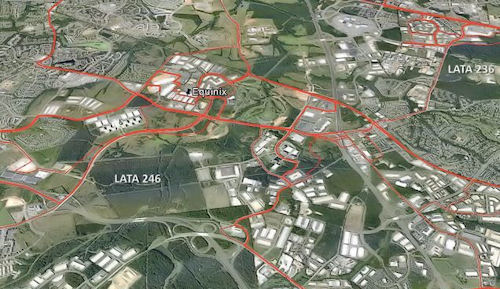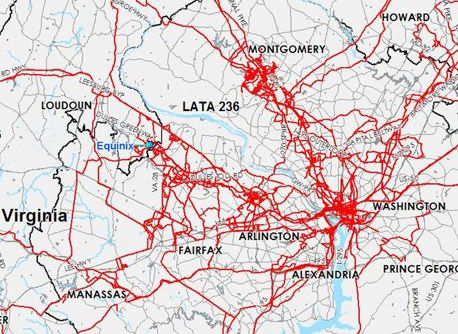
GeoTel map shows location of major fiber-optic around Equinix’s Ashburn facility, one of the largest data centers in the world.
by James A. Bacon
It is a truism that roads, highways, rail and other transportation assets are key determinants of real estate value. Less widely recognized is the fact that proximity to the “information superhighway” also affects real estate value.
In 2010, Google spent $1.9 billion to buy a 2.9-million square foot building adjacent to a fiber-optic trunk line in a consolidation of its New York advertising and engineering operations — reportedly the largest single transaction in commercial real estate history. Of 7,000 commercial real estate transactions in New York City between 2007 and 2013, 40 were data centers and 385 were fiber-lit buildings. On average the fiber-lit buildings sold for 31% more than comparable, traditional commercial real estate.
The nice thing about streets, highways and rail lines is that they are highly visible. They show up on maps. By contrast, fiber-optic lines are buried. And ownership of the lines is highly fragmented. If you’re a business and, like Google, want access to fiber trunk-line connectivity, how do you find out where to look? GeoTel Communications LLC, based in Longwood, Fla., has compiled a proprietary database of millions of miles of fiber optic routes, 350,000 cell towers and rooftop sites, and 250,000 fiber-lit buildings.
In pitching its database, GeoTel makes an interesting argument for in-fill and re-development. Much of the nation’s fiber-optic network was laid during the 1990s and early 2000s. Demand did not materialize as rapidly as expected, with the result that there are “billions to trillions of dollars” of unused fiber-optic cable — a fiber-optic graveyard — lies buried across America.
That graveyard could be buried treasure. Longmont, Colo., recently located and repurposed an 18-mile fiber loop that had been installed for $1.1 million by a local power company and sat unused every since. It’s a silicon rush in Longmont as local companies clamor to hook up to a network that sometimes runs three times faster than what they had before.
“If cities want to revitalize their economy and increase jobs, high-speed connectivity is a must,” writes Fitzalan Crowe for GeoTel. “Behind cost, parking and location, access to advanced communication services is the number one selling point for commercial real estate and economic development.”
The map above shows three corridors of fiber-optic trunk line radiating out from Washington, D.C., one toward Rockville-Gaithersburg, Md., one toward Arlington-Fairfax, and a lesser one toward Baltimore. Insofar as fiber-optic cable is critical infrastructure for the knowledge economy, especially the technology-intensive enterprises in the Washington region, Fairfax, Arlington, Alexandria, Manassas and the eastern fringe of Loudoun County near Washington Dulles International Airport are far better positioned than outer precincts to capture job growth in the years ahead.



